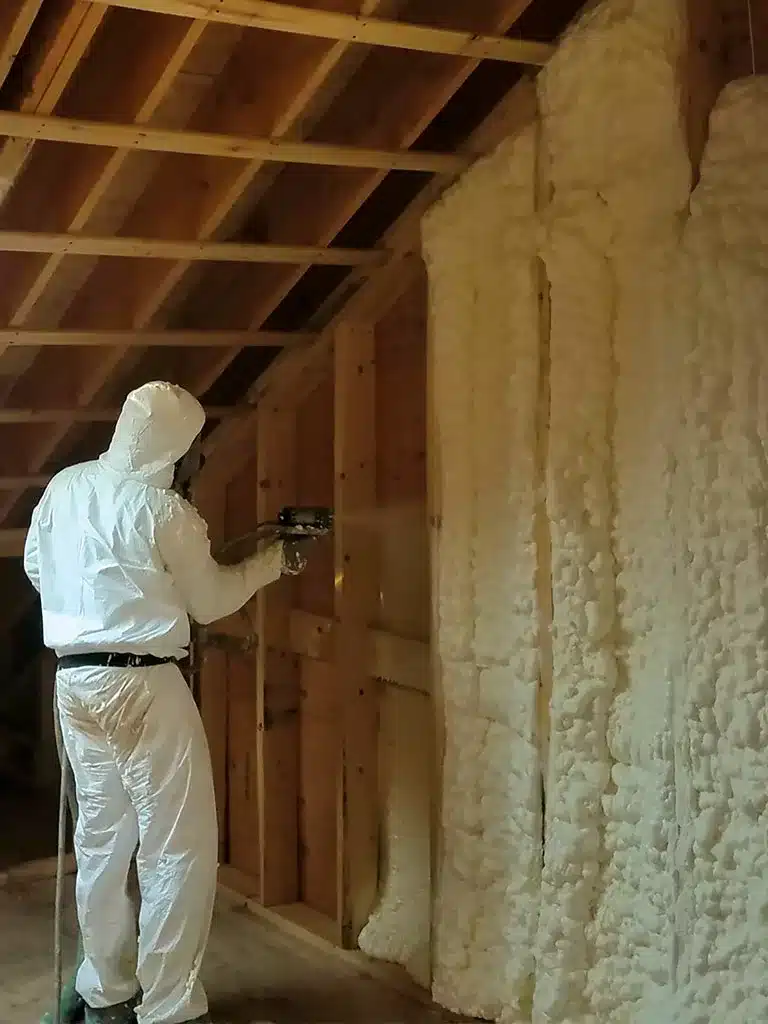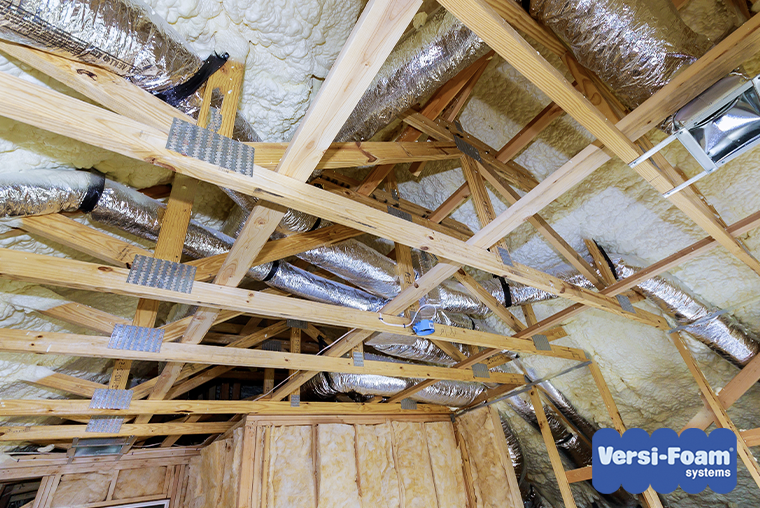Contrasting Spray Foam to Traditional Insulation: Which Is Better?
Contrasting Spray Foam to Traditional Insulation: Which Is Better?
Blog Article
Exactly How Spray Foam Can Boost Energy Effectiveness in Any Building
Spray foam insulation has actually emerged as an essential service for improving power performance across different building kinds. By producing a closed seal that decreases air leak, it efficiently regulates interior environments while dramatically reducing heating and cooling expenses. Its remarkable R-value and moisture-resistant residential or commercial properties add to lasting power cost savings and improved building longevity. As home owners progressively seek sustainable remedies, the effects of spray foam insulation prolong past plain utility savings. The full scope of its advantages, nevertheless, warrants a closer examination of how it can transform energy monitoring strategies in both household and industrial settings.
Comprehending Spray Foam Insulation
Spray foam insulation is significantly identified for its premium thermal efficiency and flexibility in different applications. Made up primarily of polyurethane, this insulation product is applied as a liquid that expands upon contact, filling spaces and developing a seamless barrier. This one-of-a-kind property enables spray foam to satisfy irregular surface areas, making it an optimal choice for both business and property frameworks.

Application of spray foam insulation is commonly done by trained specialists using specialized devices, guaranteeing optimum performance and safety - Spray Foam. The curing procedure is quick, permitting quick installation and marginal disruption. Therefore, spray foam insulation is progressively being used in brand-new building and retrofitting projects due to its ability to boost architectural honesty while boosting general power effectiveness in structures
Benefits of Power Effectiveness
Energy performance plays an essential role in lowering operational costs and decreasing ecological impact throughout numerous markets. By maximizing power usage, home owners and services can achieve considerable cost savings on utility expenses, which directly enhances financial performance. Effective power intake implies less dependence on fossil fuels, consequently adding to a decrease in greenhouse gas exhausts and advertising a much more lasting atmosphere.
Moreover, energy-efficient structures frequently experience boosted residential or commercial property values. As energy expenses rise and sustainability becomes a top priority for consumers, buildings with improved energy performance features are extra eye-catching on the marketplace. This trend urges investment in energy-saving innovations, which can further drive advancement and economic development.
In addition to ecological and monetary advantages, power efficiency can also improve the overall convenience and wellness of interior areas. Proper insulation and efficient home heating and cooling systems help preserve constant temperatures, decreasing drafts and moisture levels, which consequently can bring about far better indoor air high quality.
Inevitably, the advantages of energy efficiency expand beyond instant cost savings, fostering a resilient economic situation, advertising environmental stewardship, and enhancing the top quality of life for residents in any type of structure.
Exactly How Spray Foam Functions
Commonly used as a fluid, spray foam broadens swiftly upon call with surface areas, developing a solid obstacle that properly secures spaces and cracks. This special home is due to its chemical composition, primarily consisting of isocyanates and polyols, which respond when blended to create a foam that adheres and loads voids to numerous products, consisting of steel, concrete, and timber.
Once used, the foam increases to numerous times its original quantity, making certain a limited seal that protects against air leak. This procedure considerably lowers thermal bridging, which occurs when warm transfers blog through materials, causing power loss. The foam's high R-value, a step of thermal resistance, contributes to boosted insulation by lessening heat transfer in between the interior and exterior environments.
Additionally, spray foam is resistant to moisture and bugs, even more improving its effectiveness in preserving power performance. Its application can be customized to different areas, consisting of attic rooms, wall surfaces, and crawl areas, optimizing insulation throughout a building. Spray Foam. In general, the cutting-edge design and application approach of spray foam make it an efficient option for improving energy performance in any structure, leading to decreased energy expenses and a more lasting developed environment

Applications in Different Structures
Countless applications of spray foam insulation can be found across various building types, boosting power effectiveness and comfort. In domestic homes, spray foam is usually used in wall surfaces and attic rooms to develop a seamless obstacle versus air leakages, significantly minimizing heating and cooling demands. This application is particularly advantageous in older homes, where typical insulation might be poor.
In commercial buildings, spray foam insulation is applied to roof systems and exterior walls, which assists to improve thermal efficiency and secure versus moisture intrusion. Its light-weight nature makes it an excellent option for retrofitting existing frameworks without including considerable weight. In addition, spray foam can be used in commercial setups to protect pipes and tank, maintaining temperature level control for delicate materials.
Institutional structures, such as institutions and healthcare facilities, take advantage of spray foam insulation by ensuring a constant indoor environment that supports passenger convenience and health and wellness. The web link adaptability of spray foam enables it to adapt to numerous building sizes and shapes, making it a preferred choice for architects and contractors seeking effective insulation solutions. In general, spray foam insulation functions as an essential element in accomplishing energy-efficient buildings throughout all markets.
Long-Term Price Savings
Spray foam insulation uses substantial long-term expense financial savings for building proprietors and owners by lowering power consumption and reducing energy costs. By providing a superior air seal, spray foam minimizes the infiltration of outdoors air, thereby enhancing the thermal performance of a building. This results in more effective home heating and cooling down processes, which can lead to substantial decreases in energy prices with time.
In enhancement to prompt savings on energy expenses, the resilience and long navigate here life of spray foam insulation add to its monetary benefits. Unlike standard insulation materials, which may sag, resolve, or weaken, spray foam preserves its performance for decades, decreasing the demand for regular substitutes or repair services. This durability translates to decrease maintenance costs and less disturbance for residents.
Additionally, structures equipped with spray foam insulation often enjoy a rise in residential property value, making them much more appealing to potential purchasers or lessees. As energy effectiveness comes to be significantly prioritized, residential properties with efficient insulation services stick out out there. Ultimately, the integration of spray foam insulation not just enhances comfort however additionally stands for a calculated investment that generates considerable economic advantages over the lengthy term.
Conclusion
To conclude, spray foam insulation functions as an essential part in improving power efficiency across varied structure kinds. Its capacity to produce a seamless barrier versus air leak, combined with moisture-resistant residential or commercial properties and high r-values, significantly decreases energy intake and associated costs. The application of spray foam not just adds to constant interior temperature levels however also boosts property worth, underscoring its function as a prudent financial investment for both commercial and residential residential or commercial properties.
Spray foam insulation has arised as a critical option for improving energy effectiveness throughout numerous structure types. Spray Foam. As an outcome, spray foam insulation is significantly being used in brand-new building and construction and retrofitting jobs due to its capability to boost architectural integrity while enhancing general energy effectiveness in structures
On the whole, the cutting-edge design and application approach of spray foam make it a reliable service for enhancing power effectiveness in any structure, leading to decreased energy costs and a much more lasting constructed setting.
Countless applications of spray foam insulation can be found throughout different building kinds, improving energy effectiveness and comfort.In verdict, spray foam insulation offers as a vital element in boosting energy performance throughout varied structure kinds.
Report this page